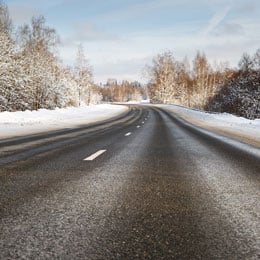 Each year, Mother Nature throws a variety of different winter conditions at us, including warm/cold temperatures, snow, rain, and a wintery mix. She's done an excellent job of mixing it up. Just when we think we're in for the deep freeze, a few days go by and the temperatures go back above freezing.
Each year, Mother Nature throws a variety of different winter conditions at us, including warm/cold temperatures, snow, rain, and a wintery mix. She's done an excellent job of mixing it up. Just when we think we're in for the deep freeze, a few days go by and the temperatures go back above freezing.
The problem with temps that hover around the freezing mark is that it creates fog, freezing fog, and black ice, which are a few of the dangers motorists face.
Black ice is a thin sheet of ice commonly found on bridges, overpasses, and shaded roadways. It forms when the temperature hovers around 32 degrees Fahrenheit and we get rain, freezing rain, or sleet. When the precipitation hits the roadway that's colder than 32 degrees, it causes ice to form, creating hazardous driving conditions.
Because black ice is thin and transparent, it's tough to see when driving. If you're out on the roadways during a wintery mix, here are some tips to keep you safe.
1. Pay attention to your local weather forecast.
If you're driving in an area where the temperature is hovering around freezing and precipitation is expected, be on the lookout for icy conditions and slow down. Please remember to be especially careful on bridges and overpasses. Lastly, please pay attention to the temperature display in your car; it's another way to figure out what Mother Nature is doing.
2. Watch for tire spray.
Because I'm a cautious driver, other cars will frequently pass me when driving conditions are poor. When the temperature hovers around freezing and another vehicle passes me, I look at the passing motorist's tires. If you see a lot of water spraying off the tires, the road surface is still wet. If you don't see water spray, the precipitation could be freezing on the roadway.
3. Be on the lookout.
Since black ice is transparent and thin, it can be tough to see. However, if black ice is present, the roadway may be darker in some spots and lighter in others. Again, please be careful on bridges and overpasses, even if the roadway looks clear.
4. Stay in your happy place.
Find a driving lane where you're comfortable and stay there. There's no need to weave in and out of traffic in poor weather. This behavior increases your chances of hitting a patch of ice, putting you and others in significant danger.
5. Straight as an arrow.
When driving, keep your steering wheel as straight as possible. If you need to turn your wheel, make minimal inputs; don’t do anything drastic.
6. Both feet out.
Braking and accelerating in icy conditions can quickly cause you to lose control. If you realize you're driving too fast for the conditions, lift off the accelerator and let your car slow down naturally; don’t apply the brakes.
7. You aren't invincible.
Four-wheel drive vehicles are nice if you live in a snowy climate. They allow you to drive through thick snow and provide better traction in certain conditions. When it comes to ice, however, four-wheel drive doesn't offer any stopping advantages over a regular vehicle. You need to respect the poor weather conditions and drive sensibly.
8. Only use cruise control on dry pavement.
Check out the video below for an in-depth video on how black ice forms and how to handle it when driving.
How to correct a slide on an icy road (and how to prevent them) – Winter driving education
Do you have any suggestions or information you’d like to share? I’d love to hear from you. Please share them in the box below.





